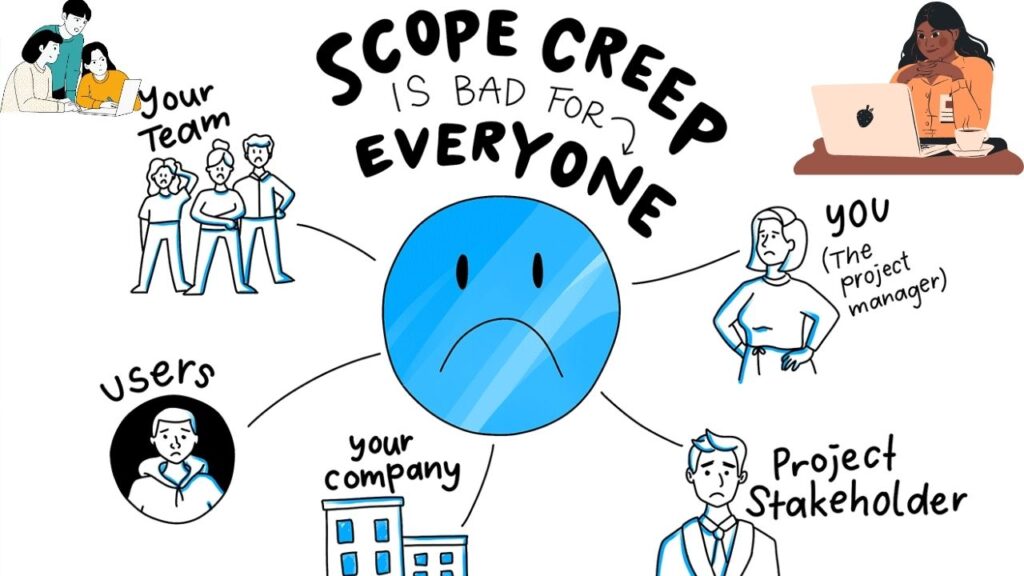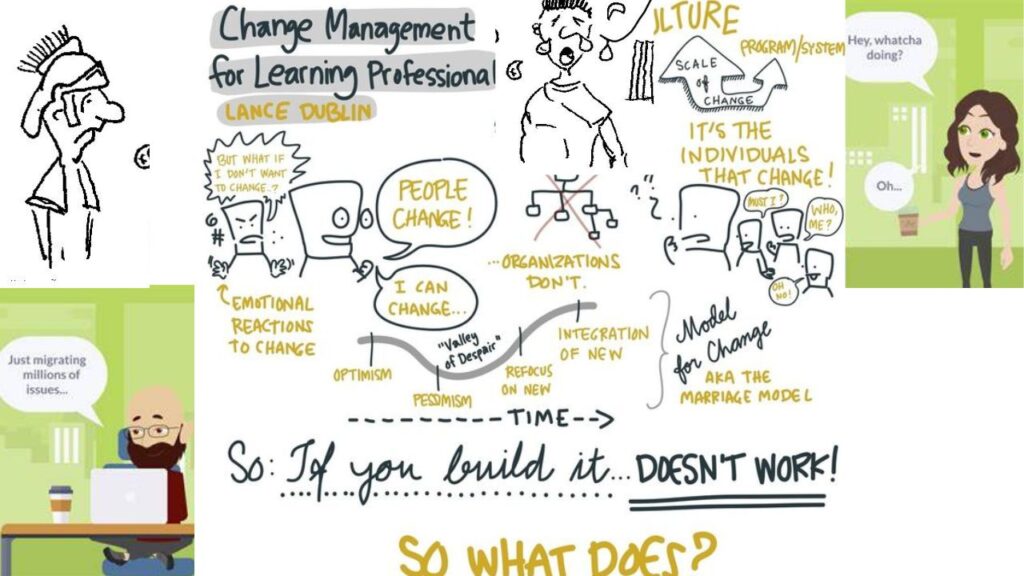Scope management challenges are an inherent part of the project management landscape. Project managers must tackle these challenges with diligence and employ strategies to mitigate their impact. Effective scope management is not just about defining project boundaries; it’s about steering the project toward its goals while adhering to timelines and budgets.
Scope Management Challenges: A Testing Ground for Project Managers
One of the most prevalent scope management challenges is the ever-encroaching menace of scope creep. This phenomenon occurs when project boundaries expand beyond the initial agreement, often fueled by evolving client expectations or uncontrolled changes in project objectives. For instance, in a software development project, additional feature requests from stakeholders can lead to scope creep, causing delays and budget overruns.
Inadequate initial planning is another pitfall that project managers must navigate. Insufficiently defined project objectives and timelines can result in unclear expectations, inaccurate resource allocation, and ballooning project costs. To mitigate these challenges, comprehensive project planning, including a well-defined scope statement, is essential.
Moreover, unclear scope definition poses a significant challenge. Vague or ambiguous scope can lead to misunderstandings, disputes, and costly rework. Utilizing tools like Work Breakdown Structures (WBS) can enhance scope definition and provide a clear roadmap for project execution.
Stakeholder involvement is a critical element of scope management, but it can also become a challenge when key stakeholders are excluded from the decision-making process. Their input is invaluable in ensuring alignment with project objectives. Neglecting stakeholder engagement may result in misalignment, dissatisfaction, and project setbacks.
Change control, a fundamental aspect of scope management, is often challenging to implement effectively. Without proper mechanisms in place, uncontrolled scope changes can destabilize a project and lead to budget overruns. Establishing formal change control processes is essential to maintaining project stability.
Lastly, the balancing act of aligning project scope with defined objectives can be a significant challenge. Ensuring that the project stays true to its intended purpose throughout its lifecycle is vital for success. Project management tools and techniques can help in this regard, facilitating alignment between scope and objectives.
Table of Contents
I. Introduction
In the realm of project management, scope management stands as a pivotal pillar that can either propel a project to greatness or lead it astray. It encompasses the planning, defining, controlling, and validating of the project’s boundaries. Effective scope management is undeniably crucial for achieving project success, as it sets the stage for clear objectives, streamlined processes, and satisfied stakeholders.
II. Importance of Effective Scope Management in Project Success
A. Defining the Project Landscape-Scope Management Challenges
Key Point: Scope management defines the project’s boundaries, outlining what is included and what is not. This clarity prevents confusion and ensures all project stakeholders are on the same page.
- Example: In a construction project, effective scope management would clearly delineate whether landscaping services are part of the project scope or if they are considered outside of it. This prevents disputes and ensures that project expectations are aligned.

B. Controlling Scope Creep
Key Point: Scope management is the guardian against the insidious villain known as scope creep. Scope creep occurs when uncontrolled changes to the project scope infiltrate, jeopardizing timelines and budgets.
- Example: Imagine a software development project where additional features are continuously added without proper change control. The project eventually spirals out of control, leading to missed deadlines and budget overruns.
C. Resource Optimization
Key Point: By effectively managing project scope, resources can be efficiently allocated. This ensures that the right people with the right skills are utilized optimally.
- Example: In a marketing campaign, if the project scope includes social media management, but it is discovered that the team lacks the expertise, resources may be better allocated to hiring a social media specialist rather than attempting to manage it internally.
D. Minimizing Risks
Key Point: A well-defined scope management plan allows for proactive risk identification and mitigation. It helps project managers foresee potential challenges and plan accordingly.
- Example: In a manufacturing project, potential risks such as supply chain disruptions can be mitigated by including alternative suppliers within the project scope. This ensures that the project can adapt to unforeseen circumstances.
E. Stakeholder Satisfaction
Key Point: Effective scope management fosters stakeholder satisfaction by setting clear expectations and delivering what is promised. It enhances trust and builds positive project relationships.
- Example: In an event planning project, scope management ensures that the client’s expectations regarding the event’s size, theme, and budget are clearly defined and met. This leads to satisfied clients and potential referrals.
Conclusion
In the intricate dance of project management, effective scope management takes center stage as a choreographer of project success. It establishes the project’s boundaries, controls scope creep, optimizes resources, minimizes risks, and keeps stakeholders satisfied. Acknowledging and proactively addressing scope management challenges is not just a choice; it’s a necessity on the path to achieving project excellence.
III. Common Project Scope Management Challenges
Project scope management is a critical aspect of project success, but it’s not without its challenges. Let’s delve into the common obstacles that project managers face when it comes to managing project scope:
A. Scope Creep– scope management challenges,
Definition of Scope Creep:
- Definition: Scope creep refers to the uncontrolled and unauthorized expansion of a project’s scope beyond its originally defined boundaries.
Reasons Behind Scope Creep:
- Lack of Clarity: Unclear project objectives and requirements can lead to scope creep as stakeholders interpret the scope differently.
- Pressure for More: Stakeholders may request additional features or changes as they gain a clearer understanding of their needs.
- Poor Change Control: Inadequate change control mechanisms can result in unmanaged scope changes.
Impact on Project Timelines and Budgets:
- Timelines: Scope creep often leads to delays as project teams struggle to accommodate additional work.
- Budgets: Expanding the scope without adjusting the budget can result in cost overruns, impacting the project’s financial health.
B. Inadequate Initial Planning– scope management challenges,
Importance of Thorough Project Planning:
- Importance: Thorough project planning, including scope definition, sets the foundation for a successful project. It ensures that all project aspects are considered and accounted for.
Consequences of Inadequate Initial Scoping:
- Scope Uncertainty: Inadequate initial scoping leads to scope ambiguity, making it challenging to manage and control project boundaries.
- Risks and Surprises: Incomplete planning increases the likelihood of encountering unforeseen issues and risks during project execution.
Mitigation Strategies:
- Comprehensive Planning: Invest time and effort into defining and documenting the project scope, objectives, and requirements.
- Engage Stakeholders: Involve key stakeholders early to ensure their expectations align with the project’s scope.
- Continuous Monitoring: Continuously monitor and update the project plan as new information becomes available.
C. Unclear Scope Definition-scope management challenges,
The Role of Clear Scope Definition in Project Success:
- Project Clarity: A clear scope definition sets the stage for a project’s success by providing a well-defined path for project teams to follow.
Consequences of Vague or Ambiguous Scope:
- Misunderstandings: Ambiguous scope leads to misunderstandings among team members and stakeholders.
- Scope Creep: Unclear scope makes it easier for scope creep to occur, as changes may be introduced without clear boundaries.
Techniques for Improving Scope Definition:
- Workshops and Brainstorming: Collaborative sessions with stakeholders to identify and define project scope.
- Prototyping: Creating prototypes or mock-ups to visualize project deliverables.
- Clear Documentation: Comprehensive documentation of scope statements and requirements.
D. Lack of Stakeholder Involvement– scope management challenges,
The Significance of Involving Stakeholders in Scope Discussions:
- Understanding Needs: Stakeholders provide valuable insights into their needs and expectations, ensuring alignment with project scope.
Risks of Excluding Key Stakeholders:
- Misalignment: Excluding key stakeholders can result in a misalignment between project outcomes and their expectations.
- Resistance: Uninvolved stakeholders may resist project changes or be dissatisfied with project results.
Strategies for Effective Stakeholder Engagement:
- Identify Key Stakeholders: Identify and prioritize stakeholders based on their influence and interest in the project.
- Regular Communication: Maintain open and regular communication channels with stakeholders to gather feedback and address concerns.
- Stakeholder Workshops: Conduct workshops or meetings to involve stakeholders in scope definition and decision-making.
E. Poor Change Control– scope management challenges,
The Importance of Change Control Processes:
- Importance: Change control processes are vital for assessing, approving, and managing scope changes systematically.
Risks Associated with Uncontrolled Scope Changes:
- Scope Creep: Uncontrolled changes can lead to scope creep, affecting project timelines and budgets.
- Quality Impact: Frequent scope changes can compromise the quality of project deliverables.
Implementing Robust Change Control Mechanisms:
- Formal Procedures: Establish formal procedures for submitting and reviewing scope change requests.
- Impact Assessment: Evaluate the impact of scope changes on timelines, budgets, and project objectives.
- Approval Process: Define a clear approval process for scope changes, involving relevant stakeholders.
F. Scope Misalignment with Objectives– scope management challenges,
The Need for Alignment Between Project Scope and Objectives:
- Alignment: The project scope should align seamlessly with the project’s overall objectives and goals.
Challenges of Maintaining Alignment: –scope management challenges,
- Changing Priorities: Evolving project priorities may lead to misalignment if scope isn’t adjusted accordingly.
- Lack of Communication: Inadequate communication can result in stakeholders not being aware of scope changes.
Tools for Ensuring Scope-Objective Coherence: –scope management challenges,
- Regular Review: Periodically review the project scope against the project objectives and adjust as necessary.
- Objective Documentation: Clearly document project objectives and ensure all scope changes align with them.
Conclusion
Effectively managing project scope is pivotal for project success. Addressing these common scope management challenges requires proactive planning, clear communication, and robust control mechanisms. By understanding and mitigating these challenges, project managers can ensure that their projects stay on course, are within budget, and deliver the intended outcomes.
IV. Case Studies: Real-World scope management challenges, Challenges in Project Scope Management
In the world of project management, the challenges of scope management are not confined to theory; they manifest themselves in real-world projects, often with profound consequences. Let’s explore some case studies that shed light on the complexities and consequences of these challenges:
A. Case Study 1: Scope Creep Strikes a Software Upgrade Project
Challenge: Scope Creep
Description: A software upgrade project for a retail company aimed to enhance their customer relationship management (CRM) system. Initially, the project scope was well-defined, with clear objectives and deliverables. However, as the project progressed, stakeholders from various departments began requesting additional features and functionalities that were not originally planned.
Consequences:
- Timeline Delays: The project faced significant delays as the team struggled to accommodate the ever-expanding scope.
- Budget Overruns: Additional work meant increased costs, leading to budget overruns.
- Stakeholder Frustration: The constant changes frustrated stakeholders, impacting their confidence in the project team.
Lesson Learned: Implementing strict change control processes and ensuring clear communication with stakeholders can help prevent scope creep.
B. Case Study 2: The Costly Consequences of Inadequate Initial Planning
Scope management Challenge: Inadequate Initial Planning
Description: An infrastructure development project for a city lacked comprehensive initial planning. The project started with a vague scope, leading to frequent scope changes and uncertainties. The project team struggled to address unforeseen challenges, resulting in missed deadlines and increased costs.
Consequences:
- Scope Uncertainty: Ambiguous initial planning made it difficult to determine the project’s boundaries.
- Rising Costs: Unforeseen issues required additional resources and funding, leading to budget overruns.
- Missed Deadlines: Constant changes and uncertainties caused delays in project delivery.
Lesson Learned: Thorough initial planning, including detailed scope definition and risk assessment, is essential to prevent costly setbacks.
C. Case Study 3: Ambiguous Scope Definition Leads to Disputes
Challenge: Unclear Scope Definition
Description: A construction project for a commercial building suffered from a vague scope definition. The project scope did not explicitly specify the responsibilities of the construction company regarding landscaping services, resulting in disagreements between the client and the contractor.
Consequences:
- Disputes: The lack of clarity led to disputes between the client and the contractor regarding who should handle landscaping.
- Project Delays: The disputes caused project delays as negotiations continued.
- Reputation Damage: The project’s reputation was tarnished due to ongoing disagreements.
Lesson Learned: Clear and comprehensive scope definition is essential to avoid misunderstandings and disputes.
D. Case Study 4: Stakeholder Disengagement Derails a Healthcare Project
Challenge: Lack of Stakeholder Involvement
Description: A healthcare IT project aimed to implement a new electronic medical record (EMR) system. However, key clinical staff were not actively involved in scope discussions and decisions. This resulted in misalignment between the EMR system’s capabilities and the clinical workflow.
Consequences:
- Workflow Disruptions: The EMR system did not align with the clinical workflow, causing disruptions and inefficiencies.
- Resistance: Clinical staff resisted using the system, impacting its adoption and effectiveness.
- Rework: Adjustments and rework were necessary to align the system with clinical needs.
Lesson Learned: Involving key stakeholders, especially end-users, is crucial for ensuring that the project scope aligns with practical requirements.
These case studies illustrate how scope management challenges can have tangible and costly consequences in real-world projects. They underscore the importance of proactive scope management, clear communication, and robust control mechanisms to mitigate these challenges and ensure project success.
IV. Strategies for Effective Scope Management
To tackle the common in project scope management challenges, it’s essential to employ effective strategies that keep your project on track and aligned with its objectives. Here are key strategies for successful scope management:
A. Clear Communication
The Role of Effective Communication in Scope Management:
- Alignment: Clear communication ensures that all project stakeholders understand the project scope, objectives, and deliverables.
- Expectation Management: It helps manage stakeholder expectations by providing transparency regarding what’s included in the project and what’s not.
Strategies for Ensuring Stakeholders Are on the Same Page:
- Regular Meetings: Conduct regular meetings with stakeholders to review the project scope, address questions, and provide updates.
- Documentation: Maintain clear and accessible documentation of the project scope, making it available to all relevant parties.
- Feedback Channels: Establish channels for stakeholders to provide feedback and seek clarifications.
B. Robust Change Control Processes
Establishing Formal Change Control Mechanisms:
- Procedures: Define formal procedures for submitting, reviewing, and approving scope change requests.
- Change Request Form: Create a standardized change request form that captures essential information about proposed changes.
- Change Control Board: Establish a change control board responsible for evaluating and approving or rejecting scope changes.
Reviewing and Approving Scope Changes:
- Impact Assessment: Assess the impact of proposed scope changes on project timelines, budgets, and objectives.
- Prioritization: Prioritize scope changes based on their significance and alignment with project goals.
- Clear Documentation: Document all scope changes, approvals, and their implications for future reference.
C. Thorough Planning
Importance of Comprehensive Project Planning:
- Scope Definition: Thoroughly define the project scope, objectives, and requirements during the planning phase.
- Risk Assessment: Identify potential risks and challenges related to scope and plan for their mitigation.
Creating a Detailed Project Scope Statement:
- Scope Statement: Develop a comprehensive project scope statement that clearly outlines what’s included and what’s excluded from the project.
- SMART Objectives: Ensure that project objectives are Specific, Measurable, Achievable, Relevant, and Time-bound.
D. Continuous Monitoring and Reporting
Regularly Tracking and Reporting on Project Scope:
- Scope Metrics: Define key scope metrics to measure progress and deviations.
- Regular Audits: Conduct periodic scope audits to ensure alignment with the project plan.
Early Identification of Scope-Related Issues:
- Issue Tracking: Implement a system for tracking and addressing scope-related issues as soon as they arise.
- Escalation: Establish an escalation process for handling critical scope issues that require immediate attention.
E. Stakeholder Engagement
Involving Key Stakeholders Throughout the Project Lifecycle:
- Early Involvement: Engage stakeholders, especially end-users, from the project’s initiation to gather their input and requirements.
- Regular Updates: Provide stakeholders with regular updates on project progress and any changes to the scope.
Soliciting Feedback and Managing Expectations:
- Feedback Loops: Create feedback loops to encourage stakeholders to share their concerns and suggestions.
- Expectation Alignment: Continuously manage stakeholder expectations by ensuring they align with the project’s scope and objectives.
These strategies form a robust framework for effective scope management, helping project managers navigate challenges, maintain project control, and deliver successful outcomes.
V. Conclusion: Overcoming Scope Management Challenges for Project Success
In the dynamic landscape of project management, effective scope management stands as a beacon of success. It is the compass that guides projects toward their objectives, ensuring that they remain on track, on budget, and aligned with stakeholders’ expectations. As we conclude our exploration of scope management challenges, let’s recap its significance and the importance of proactive engagement:
Recap of the Significance of Effective Scope Management
Effective scope management is the cornerstone of project success for several compelling reasons:
- Clarity and Alignment: It provides clarity by defining the boundaries of the project, ensuring that everyone involved understands what is included and excluded from the project scope. This alignment minimizes misunderstandings and enhances project focus.
- Control Over Scope Creep: Scope management acts as a guardian against the insidious scope creep, which can jeopardize timelines and budgets. Through clear control mechanisms, it prevents uncontrolled changes from derailing the project.
- Resource Optimization: By clearly defining the scope, project managers can allocate resources efficiently, ensuring that the right skills are applied to the right tasks. This optimization contributes to project efficiency and cost-effectiveness.
- Risk Mitigation: Effective scope management allows for proactive risk identification and mitigation. It empowers project managers to anticipate potential challenges and plan accordingly, reducing the likelihood of disruptive surprises.
- Stakeholder Satisfaction: Managing scope effectively fosters stakeholder satisfaction by setting clear expectations and delivering what was promised. It builds trust, enhances collaboration, and contributes to positive project relationships.

Encouragement to Proactively Address Scope Challenges
As we navigate the complexities of scope management, it’s imperative to remember that challenges are an inherent part of any project. However, proactive engagement with these challenges can transform them into opportunities for growth and success. Here’s an encouragement to address scope management challenges head-on:
- Early Intervention: Recognize that challenges in scope management often arise from inadequate planning, unclear communication, or unmanaged changes. Proactively address these issues during the project’s planning and initiation phases.
- Effective Communication: Establish robust communication channels with stakeholders to ensure that everyone remains informed, aligned, and engaged throughout the project lifecycle.
- Change Control: Implement rigorous change control processes to systematically evaluate and approve scope changes. This prevents unauthorized scope expansion and its associated risks.
- Comprehensive Planning: Invest time and effort into comprehensive project planning, including a well-defined project scope statement. Thorough planning sets the stage for smoother project execution.
- Continuous Monitoring: Continuously monitor and report on project scope to identify issues early. This enables timely corrective actions and minimizes disruptions.
By proactively embracing these strategies and recognizing the importance of effective scope management, project managers and teams can navigate the challenges with confidence. As the custodians of project success, they ensure that projects not only meet their objectives but also exceed stakeholder expectations, setting the stage for a brighter and more successful future in the realm of project management.



